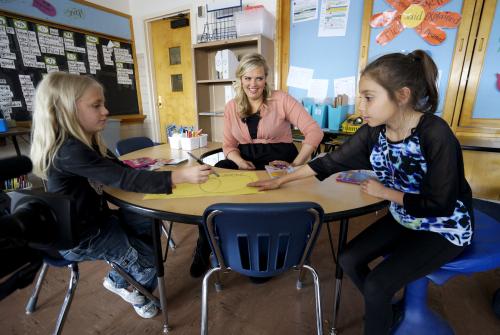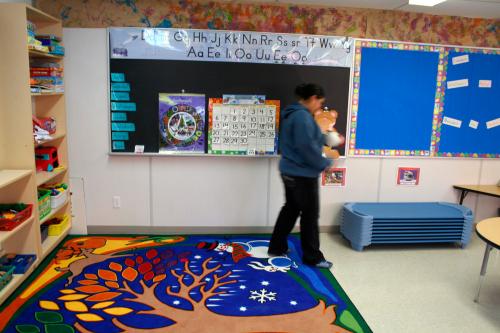Teaching is often perceived as a family-friendly profession. This perception of teaching is due not only to the notion that teaching attracts individuals who enjoy working with children, but also to the fact that teachers’ work schedules can align with their children’s school schedules. Though some argue this perception does not fit the reality of teaching, it is probably not too much of a stretch to speculate that teachers may stand out from other occupations in marriage and family behaviors.
In the spirit of Valentine’s Day, we wondered how often teachers pair up and marry other teachers, in comparison to other professions.
To explore whether teachers are more likely to marry other teachers, we look to data from the American Community Survey (ACS), a nationally representative sample of U.S. households. This dataset has information about marital status, occupation and industry and all people in each responding household, which enables us to calculate the percentage of people who are married and whose spouse works in a similar occupation. We present calculations for K-12 teachers, and compared them with four other female-dominated occupations. The sample is limited to college-educated workers between 25 and 55 years and includes about 126,000 public and private school teachers, 35,000 nurses, 28,000 post-secondary teachers, 21,000 social workers, and 15,000 secretaries.
Marriage and occupations
First, across these occupations, let’s look at the percentage of women and men with at least a bachelor’s degree who report being married.

Figure 1 shows that elementary and secondary teachers have the highest reported rates of marriage across these occupations, generally supporting the presumption that teaching may attract individuals with marriage or family considerations in mind. Additionally, in these predominantly female occupations (except for secretaries), a higher proportion of men are married than women.
It’s also relevant to consider the percentage of married people who have a working spouse. Nationally, among full-time working and married individuals, 91 percent of women’s spouses work and 78 percent of men’s spouses work. The predominantly female jobs we are comparing against have roughly comparable or slightly higher percentages of working spouses—more than 92 percent of women’s spouses work and more than 84 percent of men’s spouses work. Among elementary and secondary teachers, however, the share of working spouses notably stand out—96 percent of female teachers’ spouses work and 92 percent of male teachers’ spouses work.
Marriage within the same occupation

Next, let’s look at the rate at which people tend to marry someone within the same occupation. As previous analyses have shown, we find that people in education are remarkably likely to marry other educators. Figure 2 shows that among women, both elementary and secondary teachers marry elementary and secondary teachers, respectively, at roughly the same rate. For men, we observe a notable difference between elementary and secondary teachers; male elementary teachers are 20 percentage points more like to marry someone in the same occupation than secondary teachers.
Given that we are looking at female-dominated occupations, it is not surprising that males have a higher marriage rate within the same occupation than females. However, post-secondary teachers, regardless of their gender, have the same likelihood to marry someone in their same occupation.
Marriage within the same industry

Finally, let’s look at marriages that may transcend specific occupational titles but still work in the same industry. For instance, the industry of elementary and secondary schools includes teachers, librarians, teacher assistants, and education administrators like principals. This exercise broadens the possibility of pairing with someone who shares your same workspace. Figure 3 shows that among men, schools appear to be a great place to find a spouse—about 39 percent of men working in schools have a spouse in the same industry. For women, however, working at post-secondary institutions rather than at K-12 schools is associated with a higher likelihood of workplace romance by 7 percentage points.
Aside from being a nice Valentine’s diversion, these findings are consistent with positive assortative matching, where people with similar characteristics including level of education, socio-economic background, and race tend to pair together when forming their own families. Schools are places that cluster people with similar education, income levels, and values (desire to help children), and therefore, they seem to offer conditions that may be conducive to this type of matching behavior.
The teaching profession is notably unique in terms of labor market characteristics and demographics. It is the largest public occupation nationwide, requires a relatively high level of education, and attracts a predominantly white and female workforce, while offering relatively low salaries in comparison to other similar professions. From this analysis, it is apparent that the uniqueness of teaching goes beyond these labor market characteristics and includes marriage and family patterns.








Commentary
A Valentine’s Day card for all of our teachers
February 12, 2018